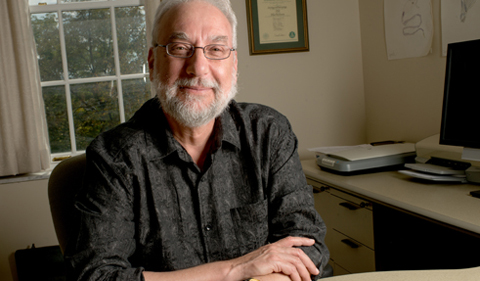Ohio University’s Dr. Elliot Abrams was selected to be a discussant at the 81st annual meeting of the Society for American Archaeology meeting in Orlando in April.
Following eight speakers on various topics ranging from Mycenaean State Formation (presented by Rodney Fitzsimmons) to an energetics approach to Celtic community building activity during the 6th century B.C.E (presented by François Remise), Abrams will end this particular session discussing the methodology he spearheaded: architectural energetics.
In his groundbreaking work, How the Maya Built Their World: Energetics and Ancient Architecture, Abrams explicated his theory of architectural energetics, which involves translating structures into volumes of raw and manufactured materials that are then multiplied by the time required for their production and assembly to determine the labor costs of past construction efforts.
“Dr. Abrams will be our discussant for the session. Reading and listening to the discussions by these scholars, Dr. Abrams will conclude our session with a discussion of his reactions to all the work presented and hopefully facilitate a broad discussion amongst the participants and members of the audience,” said symposium chair and participant Leah McCurdy.
Best summarized by Abrams and Thomas Bolland in their work “Architectural Energetics, Ancient Monuments, and Operations Management” as the method in which architectural works are translated into labor-time estimates, energetics is a technique to calculate the “cost” to build architectural works. Many fields have utilized diverse methods to calculate the “cost” of some activity or object (for example, cost could be the time needed to travel from point A to point B).
In his book How the Maya Built Their World: Energetics and Ancient Architecture published in 1994, Abrams offers a description, methodology and application of energetics within the field of archaeology.
“By converting buildings into the energy and labor expended in their construction,” Abrams writes, “a series of reconstructions concerning social power, labor organization, and economics can be generated.”
Abrams wished to contribute in overcoming the challenge of reconstructing cultural institutions, behaviors and ideas from the material remains of the past that all archaeologists face. He explains further in his book that “the architectural remains represent one of the most durable, conspicuous, and culture-laden artifacts available to archaeologists, and the present study exemplifies one approach to the study of ancient architecture.”
With this approach, Abrams was able to conduct experiments at Maya sites in Copán, Honduras, convincing him that one of the large palaces was built by roughly 300 people in only 100 days.
However, the importance of architectural energetics calculations is useful outside of Central American and Mexican archaeology. For instance, a search of “architectural energetics” in the JSTOR, a digitized database of academic journals, books and primary sources, many articles pertain to architectural energetics and its usage in other research.
This symposium is intended to help bring together the many scholars and researchers that utilize the methodology set out by Abrams in his 1994 book.
“This is an opportunity to get architectural energetics scholars in the same room to talk about their work and innovations for the future,” said McCurdy, who hopes, as someone who utilizes energetics herself, to “communicate broadly about the usefulness of this methodology.”




















Comments